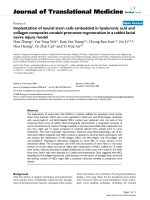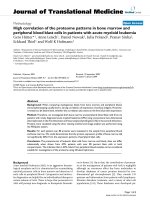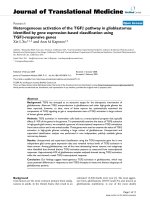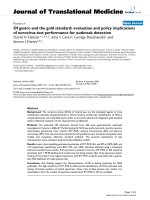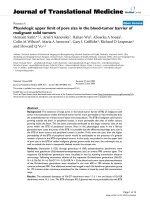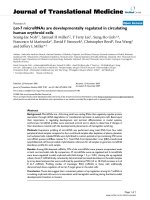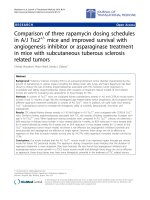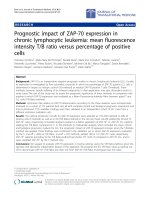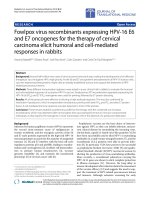báo cáo hóa học:" Disease Progression Among Untreated HIV-Infected Patients in South Ethiopia: Implications for Patient Care" pot
Bạn đang xem bản rút gọn của tài liệu. Xem và tải ngay bản đầy đủ của tài liệu tại đây (593.7 KB, 7 trang )
BioMed Central
Open Access
Page 1 of 7
(page number not for citation purposes)
Journal of the International AIDS Society
Research article
Disease Progression Among Untreated HIV-Infected
Patients in South Ethiopia: Implications for Patient Care
Degu Jerene*
1
and Bernt Lindtjørn
2
Address:
1
HIV/AIDS Coordinator, Arba Minch Hospital, Arba Minch, Ethiopia; PhD Candidate, Centre for International Health, University of
Bergen , Bergen, Norway and
2
Professor, Centre for International Health, University of Bergen, Bergen, Norway
Email: Degu Jerene* -
* Corresponding author
Abstract
Context: The natural course of HIV disease progression among resource-poor patient
populations has not been clearly defined.
Objective: To describe predictors of HIV disease progression as seen at an outpatient clinic in a
resource-limited setting in rural Ethiopia.
Design: This prospective cohort study included all adult HIV patients who visited an outpatient
clinic at Arba Minch hospital in South Ethiopia between January 30, 2003 and April 1, 2004. Clinical
and hematologic measurements were done at baseline and every 12 weeks thereafter until the
patient was transferred, put on antiretroviral therapy, was lost to follow-up, or died. Community
agents reported patient status every month.
Setting: A district hospital with basic facilities for HIV testing and patient monitoring.
Main Outcome Measures: Death, diagnosis of tuberculosis, and change in disease stage.
Results: We followed 207 patients for a median duration of 19 weeks (range, 060 weeks). A total
of 132 (64%) of them were in WHO stage III. The overall mortality rate was 46 per 100 person-
years of observation (PYO). Mortality increased with advancing disease stage. Diarrhea, oral thrush,
and low total lymphocyte count were significant markers of mortality. The incidence of tuberculosis
was 9.9 per 100 PYO. Baseline history of easy fatigability and fever were strongly associated with
subsequent development of tuberculosis.
Conclusion: The mortality rate and the incidence of tuberculosis in our cohort are among the
highest ever reported in sub-Saharan Africa. We identified oral thrush, diarrhea, and total
lymphocyte count as predictors of mortality, and easy fatigability and fever as predictors of
tuberculosis. The findings have practical implications for patient care in resource-limited settings.
Introduction
Rates of disease progression in human immunodeficiency
virus (HIV)-infected patients differ between populations
due to differences in viral subtypes, host factors, or the
environment.[1] However, our knowledge about the pat-
tern of disease progression in HIV infection in developing
countries is limited.[2] The few studies done in Africa and
other developing countries show that the rate of disease
progression is faster among resource-poor patient popula-
tions.[3-6] A recent study from Uganda, however,
Published: 30 August 2005
Journal of the International AIDS Society 2005, 7:66
This article is available from: />Journal of the International AIDS Society 2005, 7:66 />Page 2 of 7
(page number not for citation purposes)
reported that the rate of disease progression is similar in
developed and developing countries.[7] The pattern of
disease progression among Ethiopian patients has not
been studied.
Moreover, with the availability of highly active antiretro-
viral therapy (HAART), such studies became impossible
for ethical reasons. In South Ethiopia, we started to treat
HIV patients with HAART in August 2003. Prior to the
start of HAART, HIV-infected patients were registered and
followed as part of a clinic to treat opportunistic infec-
tions. Here, we present the results from a cohort of HIV
patients from south Ethiopia who did not receive HAART.
The objective of this study was to describe the natural
course of HIV disease progression as seen at an outpatient
clinic in a resource-limited setting in rural Ethiopia.
Methods
Background
This study was conducted at Arba Minch Hospital (AMH),
located 500 km south of Addis Ababa. The hospital has
158 beds and serves a population of nearly 1.5 million.
AMH has been doing HIV counseling and testing since the
early 1990s. Since January 2002, the HIV unit has been
upgraded to serve as a clinic for opportunistic infections.
Since August 2003, antiretroviral therapy (ART) has been
given to the patients, following the World Health Organi-
zation (WHO) and national recommendations.[8,9]
Both rapid and enzyme-linked immunosorbent assay
(ELISA) tests were used for HIV testing. We used an auto-
mated hematology analyzer (Sysmex Kx-21; Sysmex Cor-
poration; Kobe, Japan) for the measurement of
hematologic parameters. A semi-automatic photometer
(Photometer 5010, Version 3.0; RIELE; Berlin, Germany)
was used for the clinical chemistry tests.
Patients and Study Design
This was a prospective cohort study. Recruitment into the
study began in January 30, 2003 and patients were fol-
lowed through April 1, 2004. Although ART was intro-
duced in August 2003, recruitment into the treatment was
withheld until end of December 2003 when a guideline
on the fee scheme was issued by the hospital manage-
ment. All consenting HIV-positive patients older than 15
years of age and residing within the hospital's catchment
area were eligible for the study. Initial assessment
included basic sociodemographic variables, past medical
history, presenting complaints, history of present illness,
physical examination including weight and height, and
complete blood cell count (CBC). Chest x-ray and acid-
fast bacilli stain (AFB) were done per clinical indication.
We defined and categorized tuberculosis according to the
National Tuberculosis and Leprosy control manual of
Ethiopia.[10]
Staging and Follow-up
We staged patients according to the WHO clinical staging
system[11] before doing the laboratory investigations.
Symptomatic patients were given treatment according to
the specific diagnosis. We scheduled 12-weekly follow-up
for all patients unless indicated otherwise. At each regular
visit, we interviewed patients for new symptoms and
examined for new clinical findings. We also did a CBC at
each regular visit.
Community Agents
We employed 2 secondary school graduates with basic
training on HIV counseling as community agents to fol-
low the patients at the community level. We assigned each
of them to the newly recruited patients with their contact
details. The agents visited them monthly and offered
home-based counseling and support.
Endpoints
Death, change in clinical stage (for stages I, II, and III),
and diagnosis of tuberculosis were the main outcome var-
iables. Death at community level was ascertained through
community agents. The data clerk at the clinic reported
hospital deaths on patient record. Patients who left the
study area permanently were labeled as transferred.
Patients were regarded as being in care if they had follow-
up or initial visit within the previous 90 days before the
end of the study and community agents reported that the
patient was alive. Patients were regarded as lost to follow-
up if they had not had a visit within the previous 90 days
and the responsible community agent reported that the
patient was lost. We closed the pre-ART follow-up period
between January 1, 2004 and April 1, 2004. We followed
90 days into the ART period until we obtained endpoint
measurements on all patients, including those on their
12-weekly appointments. Patients who were put on ART
were censored at the date of treatment initiation.
Statistical Analysis
We used SPSS for Windows version 12.0 for data analysis.
All completed patient data were entered into SPSS on the
same day of examination. Follow-up data were also han-
dled similarly. We evaluated the WHO clinical stage, oral
candidiasis (oral thrush), diarrhea, body mass index
(BMI), total lymphocyte count (TLC), and hemoglobin
(Hgb) as predictors of death in our patients. The TLC was
treated as a dichotomous variable at a cut-off value of
1200 cells/mL because of its clinical significance for the
initiation of ART.[8] Similarly, we used the cut-off value
18.5 kg/m
2
for BMI.[12] Because we do not have normal
values for Hgb in the study area, we used an arbitrary cut-
off value of 10 g/dL for both men and women. This is the
cut-off value below which treatment with zidovudine-
containing regimen is not recommended.[8] All of the
clinical symptoms were treated as dichotomous variables.
Journal of the International AIDS Society 2005, 7:66 />Page 3 of 7
(page number not for citation purposes)
We used the Kaplan-Meier method to determine the
event-free survival, and the log-rank test was used to assess
the statistical significance. In order to determine the rela-
tive risk for death we used the Cox-regression method.
The hazard ratio (HR) was used to determine the differ-
ence in the relative risk for death, and it was described as
95% confidence interval (95% CI). We calculated death
rates as death per 100 PYO.[13]
A patient was considered to have progressed to the next
highest WHO stage provided that he or she presented with
a new stage-defining event[12] at 12 weeks or later follow-
ing the initial examination. The date of staging was con-
sidered the date of progression. We estimated the rate of
disease progression by the Kaplan-Meier method for
patients in stages I, II, and III.
Tuberculosis incidence was calculated as number of tuber-
culosis cases per 100 PYO. We calculated 95% CIs of rates
and rate ratios of tuberculosis incidence assuming Poisson
distribution of tuberculosis occurrence. All patients were
considered to be at risk of developing tuberculosis during
follow-up. Patients already on treatment were also consid-
ered at risk because of the risk of reinfection. We evaluated
fever, easy fatigability, cough, past history of tuberculosis,
TLC 1200/mL, and WHO stage as possible predictors of
tuberculosis by the Kaplan-Meier and Cox-regression
methods as described above.
Proportions of relevant variables were compared using the
chi-squared test. Statistical tests were considered signifi-
cant if the 2-sided P value was < .05.
Ethical Considerations
The study protocol was approved by the National Ethics
Review Committee in Ethiopia and by the Regional Com-
mittee for Medical Research Ethics in Western Norway.
HIV testing was done after informed written consent fol-
lowing a pretest counseling session. Patients were offered
the available treatment irrespective of their consent to par-
ticipate in the study. It is not the Ethiopian policy to give
isoniazid (INH) prophylaxis to adult HIV-infected
patients.[11]
Results
Sociodemographic Characteristics
We enrolled and followed 207 patients between January
30, 2003 and April 1, 2004. A total of 191 (92%) patients
came from urban areas, mostly (168 patients, 81%) from
Arba Minch town. Their median age was 30 years (range,
1775 years). More than one third of the patients were
divorced, widowed, or separated. Almost one third were
unemployed, and one third had no formal education. A
quarter of them came with a letter of exemption from fee
for medical services, and their mean monthly income was
about US$26.
Clinical Characteristics at Initial Examination
In total, 132 (64%) patients were in WHO stage III at ini-
tial examination (Table 1). Cough was the most common
presenting complaint (82 patients, 40%) followed by
weight loss (73 patients, 35%) and diarrhea (69 patients,
33%). Silky hair (softening, straightening, and loss of
scalp hair) was found in 21% of the patients. None of
patients in stage I had silky hair but 7%, 27%, and 28% of
patients in stages II, III and IV respectively had silky hair
(chi-squared test for trend = 27, df = 3, P < .01). Dermatitis
(68 patients, 33%), oral thrush (67 patients, 32%), and
tuberculosis (55 patients, 27%) were the 3 most common
additional diagnoses at initial examination. Kaposi's sar-
coma (5 patients, 2.4%), esophageal candidiasis (3
patients, 1.5%), and Pneumocystis carinii pneumonia (1
patient, 0.5%) were rarely diagnosed.
Additionally, 45 (19%) patients had a past or present his-
tory of herpes zoster and 46 (22%) patients gave past his-
tory of at least 1 episode of tuberculosis. At enrolment, 55
(27%) patients either were on treatment for tuberculosis
or were diagnosed to have tuberculosis. Smear-negative
pulmonary tuberculosis (PTB-) was the most common
type (30 of 55 patients, 54%), followed by smear-positive
pulmonary tuberculosis (PTB+; 11 out of 55 patients,
20%), extrapulmonary tuberculosis (EPTB; 9 out of 55
patients, 16%), and unspecified in 5 out of 55 patients
(9%).
Patient Follow-up
The median duration of follow-up was 19 weeks (range,
060 weeks). By the end of the study, 47 (23%) patients
had died, 11 (5%) patients were lost to follow-up, 9 (4%)
were transferred to another health institution, 51 (25%)
were put on ART, and 89 (43%) were under regular fol-
low-up and not yet put on ART.
Table 1: Distribution of Patients in Each WHO Stage at
Presentation, Arba Minch Hospital, 2004
WHO Stage Number of Patients Percentage
I 22 11%
II 28 13%
III 132 64%
IV 25 12%
Total 207 100%
WHO = World Health Organization
Journal of the International AIDS Society 2005, 7:66 />Page 4 of 7
(page number not for citation purposes)
Mortality Rates
A total of 47 patients died during follow-up, all due to
HIV-related conditions. Thus, the overall rate of mortality
was 46 per 100 PYO (47 deaths/101.3 person-years of
observation). Mortality increased with advancing disease
stage. At the end of the study period, the proportion of
patients who died was 0%, 11%, 36%, and 40% in stages
I, II, III, and IV, respectively (log-rank test; chi-squared =
18.5, P < .001) (Figure 1). Patients with diarrhea (chi-
squared = 11.4, P = .001), oral thrush (chi-squared = 23.5,
P < .001), low lymphocyte count (TLC 1200 cells/mL)
[chi-squared = 10.2, P = .001], low body mass index (BMI
< 18.5 kg/m
2
) [chi-squared = 8.2, P = .004], or anemia
(Hgb 10 g/dL for both sexes) [chi-squared = 9.0, P = .003)
had significantly higher mortality. Nevertheless, when
stratified by disease stage, only diarrhea and oral thrush
remained significant markers of death (Figure 2).
In the Cox-regression model that contained diarrhea, oral
thrush, low TLC, low BMI, WHO stage III and IV, and ane-
mia, only oral thrush and low TLC remained significant
markers of mortality (HR [95% CI = 3.5 [1.86.7] and 3.5
[1.48.4] for oral thrush and for low TLC, respectively)
(Table 2).
Incidence of Tuberculosis
Ten patients (5 men and 5 women) developed tuberculo-
sis during follow-up. One patient developed PTB+, 2
developed EPTB, and the other 7 were PTB-cases. The
overall incidence rate of tuberculosis was 10 cases/101.3
PYO = 9.9 cases per 100 PYO (95% CI, 8.112.0). The inci-
dence rate was higher in patients with stage III and IV dis-
ease (8/70.5 PYO = 11.4 per 100 PYO) than stage I and II
combined (2/30.9 PYO = 6.5 per 100 PYO), but the differ-
ence was not statistically significant (incidence rate ratio =
1.8; 95% CI = 0.48.2). Patients with baseline history of
easy fatigability (chi-squared = 16.8, P < .001) and fever
(chi-squared = 22.0, P < .001) were more likely to develop
tuberculosis during follow-up. There was no significant
association with past history of tuberculosis (chi-squared
= 3.2, P = .073; log-rank test).
In the Cox-regression model that contained cough, fever,
easy fatigability, and WHO stage III and IV, only fever (HR
= 15.6, 95% CI = 2.887.5, P = .002) and easy fatigability
(HR = 9.2, 95% CI = 1.944.5, P = .006) were significant
predictors of tuberculosis (Table 3).
Change in Clinical Stages
Only 9 patients progressed to a higher disease stage during
follow-up 5 from stage I to II, 2 from stage II to III, 1 from
III to IV, and 1 progressed directly from stage I to III. Evi-
dence for progression from stage I to II were weight loss
between 5% and 10% of body weight in 4 cases, and
repeated upper respiratory tract infection in 1 patient.
Patients with initial stage I disease had the highest risk of
Survival according to initial WHO stage, Arba Minch Hospi-tal, 2004Figure 1
Survival according to initial WHO stage, Arba Minch
Hospital, 2004.
1.0
0.8
0.6
0.4
0.2
0.0
Weeks
Log rank; P < 0.001
IV
III
II
I
Proportion Alive
0 5 10 15 20 25 30 35 40 45 50 55 60 65 70
Kaplan-Meier estimates of survival in patients with and with-out history of diarrhea and oral thrush, Arba Minch Hospital, 2004Figure 2
Kaplan-Meier estimates of survival in patients with
and without history of diarrhea and oral thrush, Arba
Minch Hospital, 2004.
1.0
0.8
0.6
0.4
0.2
0.0
1.0
0.8
0.6
0.4
0.2
0.0
Diarrhea in Stage IV
Weeks
Proportion Alive
P < 0.01
Yes
No
0 1020304050
60
1.0
0.8
0.6
0.4
0.2
0.0
Diarrhea in Stage III
Weeks
Proportion Alive
Yes
P = 0.03
No
0 10203040506070
1.0
0.8
0.6
0.4
0.2
0.0
0 102030
Oral Thrush in Stage III
Weeks
Proportion Alive
40 50
Yes
P = 0.03
No
60 70
Oral Thrush in Stage IV
Weeks
Proportion Alive
Yes
P < 0.01
No
0 102030405060
Journal of the International AIDS Society 2005, 7:66 />Page 5 of 7
(page number not for citation purposes)
a new stage-defining event (log-rank test; chi-squared =
21, P < .001).
Discussion
In this study, we found a very high mortality rate and a
very high incidence of tuberculosis. We identified oral
thrush and low TLC as strong predictors of death among
our patients. Baseline history of easy fatigability and fever
predicted subsequent development of tuberculosis. The
risk of new stage-defining event was highest among
patients with stage I disease. Additionally, we identified
silky hair as a sign of advanced HIV disease.
However, the findings should be interpreted cautiously
because of some limitations in the study design. The short
follow-up period did not allow us to measure the long-
term disease progression pattern in our patients. Because
of limited facilities, our diagnosis depended primarily on
the clinical picture. We also did not attempt to determine
the date of HIV infection in our patients, and hence it does
not describe the full picture of the natural history of HIV
infection. However, the findings of our study may be rep-
resentative of the actual situation in resource-limited set-
tings as we followed patients during routine activities in
the clinic. We also gathered reliable information about
the outcome of our patients because of the community
agents.
A mortality rate of 46 per 100 PYO in our cohort is prob-
ably among the highest ever reported in sub-Saharan
Africa. The high proportion of patients with advanced dis-
ease, the high magnitude of comorbid clinical conditions,
and the high death detection rate by community agents
probably contributed to the high mortality rate. In other
hospital-based studies from Africa, mortality in the
absence of HAART ranged from 10 to 35 per 100 PYO.[2]
As a comparison, a community-based study in south-cen-
tral Ethiopia showed a crude mortality rate of 11.2 per
1000 PYO among adults.[14]
Most of the incidence data for TB come from developed
countries.[15,16] From Africa, we have only limited
data.[17] An incidence rate of 9.9 per 100 PYO in our
study is about 10 times higher than that reported from a
Table 2: Hazard Ratio (HR) of Death According to Different Cox-Regression Analyses, Arba Minch Hospital, 2004
Univariate Analysis(HR [95% CI]) Multivariate Analysis(HR [95% CI])
Oral thrush (yes vs no) 3.8 (2.16.8) 3.5 (1.86.7)
TLC ( 1200/mL vs > 1200/mL) 3.0 (1.56.0) 3.5 (1.48.4)
Hgb ( 10 g/dL vs > 10 g/dL) 4.2 (1.511.8)
WHO stage (IIIIV vs III) 6.1 (2.019.2)
Diarrhea (yes vs no) 2.6 (1.54.7)
BMI (< 18.5 kg/m
2
vs 18.5 kg/m
2
) 2.5 (1.34.9)
HR = hazard ratio; CI = confidence interval; TLC = total lymphocyte count; Hgb = hemoglobin; WHO = World Health Organization; BMI = body
mass index
Table 3: Hazard Ratio (HR) for Tuberculosis Incidence According to Different Cox-Regression Analyses, Arba Minch Hospital, 2004
Univariate Analysis(HR [95% CI]) Multivariate Analysis(HR [95% CI])
Fever (yes vs no) 17.6 (3.589.4) 15.6 (2.887.5)
Weakness (yes vs no) 11.3 (2.748.9) 9.2 (1.944.5)
Cough (yes vs no) 4.3 (1.0417.4)
Past history of TB (yes vs no) 3.4 (0.814.6)
WHO stage (IIIIV vs III) 2.0 (0.49.5)
HR = hazard ratio; CI = confidence interval; TB = tuberculosis; WHO = World Health Organization
Journal of the International AIDS Society 2005, 7:66 />Page 6 of 7
(page number not for citation purposes)
research clinic in Ethiopia.[18] Ours is in agreement with
a report of 10.4 per 100 PYO from Cape Town.[17] Most
of our patients came from low socioeconomic back-
grounds where tuberculosis is rampant even without HIV.
Because we used clinical criteria, overdiagnosis of PTB-
cases could have contributed to the high incidence. How-
ever, because the data were collected under real-life situa-
tions at a district hospital, it is likely to represent the
actual tuberculosis situation. Although easy fatigability
and prolonged low-grade fever are often described as non-
specific symptoms of tuberculosis,[10] patients with these
symptoms may require more frequent monitoring for
tuberculosis.
Presence of diarrhea remained a significant marker of
death in patients with stages III and IV disease. Because
diarrhea is an easily recognizable symptom, history of
diarrhea should always be determined during clinical
examinations even when other stage-defining events are
present. Whether diarrhea could predict mortality in
patients receiving ART needs further evaluation. Further
studies should also attempt to identify definitive causes of
diarrhea and their prognostic values in such settings.
Several authors have described the prognostic value of
oral candidiasis, BMI, TLC, and anemia.[19-25] We fur-
ther confirm the prognostic value of oral thrush and low
TLC but not of BMI and hemoglobin levels in patients
who are not receiving ART. Additionally, we found that
the mortality rate was higher in patients with oral candi-
diasis within the same WHO stage. The WHO now recom-
mends initiation of ART for all patients in stage III if there
are no facilities for performing CD4+ cell counts.[8] In
settings with scarce resources, priority should be given to
patients with oral thrush.
Some authors reported silky hair (the "straight hair sign")
as a sign of HIV infection, while others argued that it is not
pathognomonic for HIV infection.[26-28] Its pathogene-
sis is not known but some reported it as being a manifes-
tation of mitochondrial abnormality.[29] Although there
are no published reports from Ethiopia, silky hair is
included as a minor sign in the Ethiopian AIDS case defi-
nition.[30] This sign is not included in the WHO staging
system.[11] Because more than a quarter of our patients
with stage III and IV disease had silky hair, we suggest that
it be included as a sign of advanced HIV infection in Afri-
can patient populations. Whether the hair changes to its
normal status with ART needs further investigation.
The apparent high risk for change in disease stage among
asymptomatic patients could be due to the minor weight
loss, which could occur with similar frequency in both
HIV-positive and HIV-negative individuals as reported
from Uganda.[6] Minor weight loss and pulmonary tuber-
culosis were the most commonly diagnosed conditions
among HIV-positive individuals in Ethiopia.[31] In a
multicountry study, no difference was found between
stages I and II.[32,33] Moreover, the low risk for progres-
sion among patients in advanced stage could be due to the
high mortality that probably occurred before any evidence
of stage change.
Conclusion
In conclusion, we identified simple clinical and labora-
tory markers as predictors of death and tuberculosis
occurrence. Identifying the specific stage-defining condi-
tions could be of practical importance for patient coun-
seling and for clinical decision-making in resource-
limited settings. The prognostic value of these markers in
patients receiving ART needs further investigation. History
of easy fatigability and fever should be asked routinely in
HIV-positive patients in order to identify patients at
immediate risk of developing clinical tuberculosis. These
symptoms could also identify patients who might benefit
from tuberculosis prophylactic therapy. We recommend
that INH prophylaxis be included as part of the standard
package of care for Ethiopian HIV-infected patients.
Funding Information
The HIV/AIDS project of AMH was funded by the Norwe-
gian Agency for Development Cooperation (NORAD).
Authors and Disclosures
Degu Jerene, MD, has disclosed no relevant financial rela-
tionships.
Bernt Lindtjørn, MD, PhD, has disclosed no relevant
financial relationships.
Acknowledgements
We thank Samuel Mamo and Temesgen Girmaye for performing the labo-
ratory tests. We are grateful to Dr. Yewubnesh Hailu for participating in
the recruitment of patients. We are also grateful to Asnakech Abayneh, the
data clerk, and to Tesfalem Babena and Feven Fetene, the community
agents, for their excellent work in tracing and recording patient informa-
tion. Tamirat Seyoum, Tolosa Tomas, and Tadele Roba did most of the
counseling.
References
1. Hogan CM, Hammer SM: Host determinants in HIV infection
and disease. Part 2: Genetic factors and implications for
antiretroviral therapeutics. Ann Intern Med 2001, 134:978-996.
Abstract
2. Jaffar S, Grant AD, Whitworth JW, Smith PG, Whittle H: The natu-
ral history of HIV-1 and HIV-2 infections in adults in Africa:
a literature review. Bull World Health Organ 2004, 82:462-469.
Abstract
3. Deschamps MM, Fitzgerald DW, Pape JW, Johnson D: HIV infection
in Haiti: natural history and disease progression. AIDS 2000,
14:2515-2521. Abstract
4. Anzala OA, Nagelkerke NJ, Bwayo JJ, et al.: Rapid progression to
disease in African sex workers with human immunodefi-
ciency type 1 infection. J Infect Dis 1995, 171:686-689. Abstract
Publish with BioMed Central and every
scientist can read your work free of charge
"BioMed Central will be the most significant development for
disseminating the results of biomedical research in our lifetime."
Sir Paul Nurse, Cancer Research UK
Your research papers will be:
available free of charge to the entire biomedical community
peer reviewed and published immediately upon acceptance
cited in PubMed and archived on PubMed Central
yours — you keep the copyright
Submit your manuscript here:
/>BioMedcentral
Journal of the International AIDS Society 2005, 7:66 />Page 7 of 7
(page number not for citation purposes)
5. Morgan D, Malamba SS, Orem J, Mayanja B, Okongo M, Whitworth
JAG: Survival by AIDS defining condition in rural Uganda. Sex
Transm Infect 2000, 76:193-197. Abstract
6. Morgan D, Mahe C, Mayanja B, Whitworth J: Progression to symp-
tomatic disease in people infected with HIV-1 in rural
Uganda: prospective cohort study. BMJ 2002, 324:193-197.
Abstract
7. Morgan D, Mahe C, Mayanja B, Okongo JM, Lubega R, Whitworth
JAG: HIV-1 infection in rural Africa: is there a difference in
median time to AIDS and survival compared with that in
industrialized countries? AIDS 2002, 16:597-603.
8. World Health Organization: Scaling-up antiretroviral therapy in
resource-limited settings. Guidelines for a public health approach
2002 [ />].
Geneva: World Health Organization Accessed July 29, 2005
9. Ministry of Health/HIV/AIDS Prevention and Control Office/Drug
Administration and Control Authority: Guidelines for use of
antiretroviral drugs in Ethiopia. Addis Ababa 2003 [http://
cnhde.ei.columbia.edu/files/4/3/2004-Dec-Thu-074644]. Accessed
July 29, 2005
10. Ministry of Health: National TB and Leprosy Control Manual.
Addis Ababa: Ministry of Health; 2002.
11. World Health Organization: Acquired immune deficiency syn-
drome (AIDS): interim proposal for a WHO staging system
for HIV-1 infection and disease. Wkly Epidemiol Rec 1990,
65:221-228. Abstract
12. Food and Agriculture Organization: Body Mass Index A measure
of chronic energy deficiency in adults. Food and Nutrition Paper
56. Food and Agriculture Organization 1994.
13. Betty RK, Jonathan AC: Essential Medical Statistics 2nd edition. Lon-
don: Blackwell Publishing Ltd; 2003.
14. Berhane Y, Hogberg U, Byass P, Wall S: Gender, literacy and sur-
vival among Ethiopian adults, 198796. Bull World Health Organ
2002, 80:714-720. Abstract
15. Moreno S, Baraia-Etxaburu J, Bouza E, et al.: Risk for developing
tuberculosis among anergic patients infected with HIV. Ann
Intern Med 1993, 119:194-198. Abstract
16. Markowitz N, Hansen NI, Hopewell PC, et al.: Incidence of tuber-
culosis in the United States among HIV-infected persons.
Ann Intern Med 1997, 126:123-132. Abstract
17. Wood R, Maartens G, Lombard CJ: Risk factors for developing
tuberculosis in HIV-1-infected adults from communities with
a low or very high incidence of tuberculosis. J Acquir Immune
Defic Syndr 2000, 23:75-80. Abstract
18. Wolday D, Hailu B, Girma M, Hailu E, Sanders E, Fontanet A: Low
CD4+ cell count and high HIV viral load precede the devel-
opment of tuberculosis disease in a cohort of HIV-positive
Ethiopians. Ethiop Med J 2003, 41(suppl 1):67-73. Abstract
19. Hilton JF: Functions of oral candidiasis episodes those are
highly prognostic for AIDS. Statist Med 2000, 19:989-1004.
20. Hilton JF, Alves M, Anastos K, et al.: Accuracy of diagnoses of
HIV-related oral lesions by medical clinicians. Findings from
the Women's Interagency HIV Study. Commun Dent Oral Epide-
miol 2001, 29:362-372.
21. Nittayananta W, Chanowanna N, Sripatanakul S, Winn T: Risk fac-
tors associated with oral lesions in HIV-infected heterosex-
ual people and intravenous drug users in Thailand. J Oral
Pathol Med 2001, 30:224-230. Abstract
22. Campo J, Del Romero J, Castilla J, Garcia S, Rodriguez C, Bascones A:
Oral candidiasis as a clinical marker related to viral load,
CD4 lymphocyte count and CD4 lymphocyte percentage in
HIV-infected patients. J Oral Pathol Med 2002, 31:5-10. Abstract
23. Yared M, Nicole HD, Eduard S, et al.: Simple markers for initiat-
ing antiretroviral therapy among HIV-infected Ethiopians
[Concise communication]. AIDS 2003, 362:1625-1627.
24. Mofenson L, Harries D, Moye J, et al.: Alternatives to HIV-1 RNA
concentration and CD4 count to predict mortality in HIV-1-
infected children in resource-poor settings [Letter]. Lancet
2003, 362:1625-1627. Abstract
25. Bryan L, Stephen JG, John PP, Sharon AR, Roger D, Joseph BM: Rapid
declines in total lymphocyte counts and haemoglobin con-
centration prior to AIDS among HIV-1 infected men. AIDS
2003, 17:2035-2044. Abstract
26. Kinchelow T, Schimidt V, Ignato S: Changes in the hair of black
patients with AIDS [Letter]. J Infect Dis 1988, 157:394.
27. Leonidas JR: Hair alterations in black patients with the
acquired immunodeficiency syndrome. Cutis 1987, 39:537-538.
Abstract
28. Stephen LG, Douglas LN: Straightening of the hair is not
pathognomonic for HIV infection [Correspondence]. Clin
Infect Dis 2002, 35:1276-1277. Abstract
29. Bodemer C, Rotig A, Rustin P, et al.: Hair and skin disorders as
signs of mitochondrial disease. Pediatrics 1999, 103:428-433.
Abstract
30. Ministry of Health: Guidelines for clinical management of HIV
infection in adults in Ethiopia. Addis Ababa: Ministry of Health;
2000.
31. Kassa E, Rinke de Wit TF, Hailu E,
et al.: Evaluation of the World
Health Organization staging system for HIV infection and
disease in Ethiopia: association between clinical stages and
laboratory markers. AIDS 1999, 13:381-389. Abstract
32. Dennis HO: Classification and staging of HIV Infection. HIV
InSite Knowledge Base Chapter 1998 [ />InSite?=kb-01-01]. Accessed July 29, 2005
33. Lifson AR, Allen S, Wolf W, et al.: Classification of HIV infection
and disease in women from Rwanda: evaluation of the World
Health Organization HIV staging system and recommended
modifications. Ann Intern Med 1995, 122:262-270. Abstract
